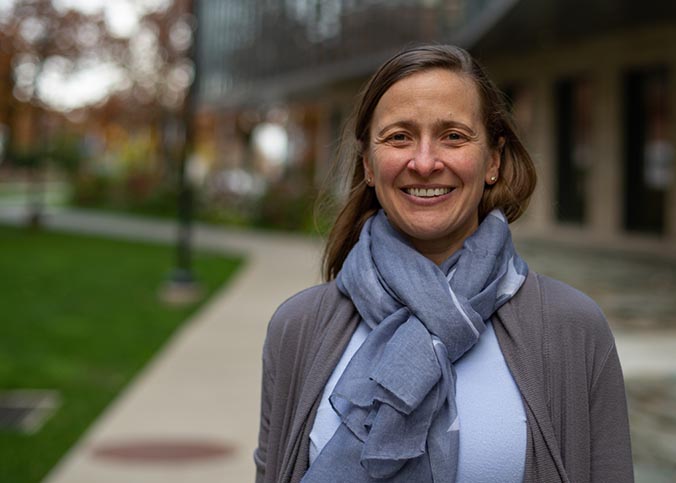
With a new grant from the National Science Foundation, Lauren Greenlee, associate professor of chemical engineering, plans to lead an international team of researchers to better understand catalysis with an iron-containing compound. IMAGE: KELBY HOCHREITHER
Grant enables research into catalysts for more sustainable hydrogen production
12/9/2021
By Gabrielle Stewart
UNIVERSITY PARK, Pa. — Fuel cells running on hydrogen gas could serve as a gasoline alternative in cars of the future. However, most hydrogen gas is derived from extracted natural gas, so an alternative method of producing the hydrogen, such as water splitting, is necessary to avoid using fossil fuels altogether, according to Lauren Greenlee, associate professor of chemical engineering at Penn State.
Recently, Greenlee received a $379,998 grant from the National Science Foundation to study electrolysis, or the process of using electricity to split water. Collaborating with researchers at the Karlsruhe Institute of Technology in Germany, she aims to better understand and ultimately improve this method by using an iron-containing compound as a catalyst to accelerate the splitting process.
“Electrolysis relies on a catalyst to produce the chemical reaction that separates the molecules in water, but all commercial devices use precious metals as those catalysts,” Greenlee said. “We want to develop catalysts that are more widely available and not based on precious metals. Iron and nickel together have been shown to be very active in the chemical reaction, so we are working on better understanding the role of iron in that process.”
To begin the investigation, Greenlee will synthesize the iron-nickel catalyst in the form of small nanoparticles as well as thin films, or layers of material ranging in size from a just few nanometers to thousands. For comparison, a sheet of paper is about 100,000 nanometers thick. Greenlee and her team will use various characterization methods, including electrochemical analysis, x-ray photoelectron spectroscopy and electron microscopy, to understand properties of the catalyst that will influence the experimentation portion of the research.
Greenlee’s collaborators will then evaluate the chemical structure of the iron-nickel catalyst, along with comparable iron-containing catalysts, in a specialized characterization cell designed to allow x-ray measurements during cell operation in a liquid electrolyte environment. To meet this goal, the team aims to advance the spectroscopy technique so that measurements can be taken more quickly and effectively on a liquid sample — typically very difficult to measure with spectroscopy, Greenlee said. Lothar Weinhardt, head of the x-ray spectroscopy department at the Karlsruhe Institute of Technology and co-principal investigator, will lead the experiments to observe both forms of the catalyst as they work in the electrochemical environment to accelerate the chemical reaction. The researchers will test different ratios of iron and nickel atoms in the catalyst’s makeup to learn how its oxidation states change — because the oxidation state and electronic structure of the metal species can dictate the performance of the catalyst and therefore lower the energy required to complete the reaction.
“Understanding the structure of the iron during the reaction is critical,” Greenlee said. “If we really understand that then we can go to groups designing catalysts and present them with an ideal design goal.”
With the three-year grant, the researchers expect that they can work toward development and testing of a more efficient iron-based catalyst, according to Greenlee. She also aims for the research to enable more robust and varied methods of energy generation, conversion and storage as well as applications in transportation.



